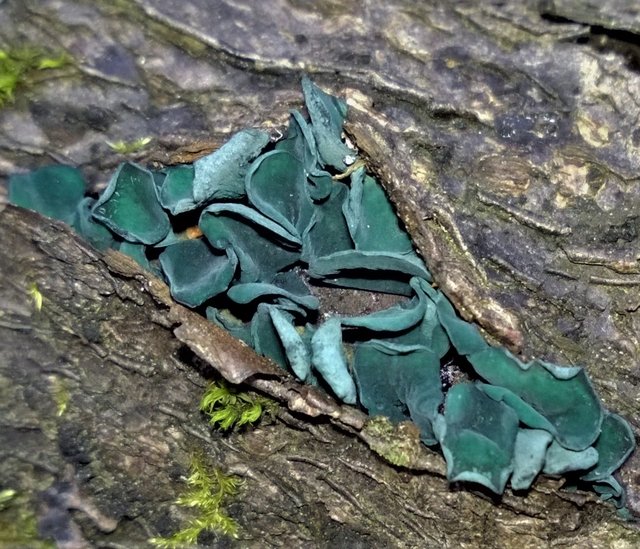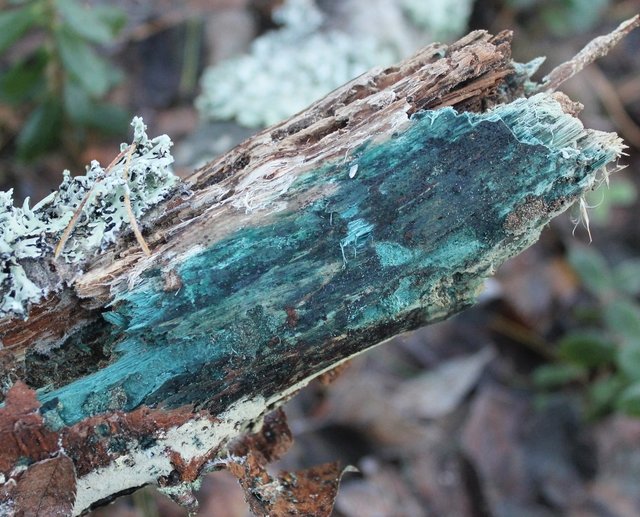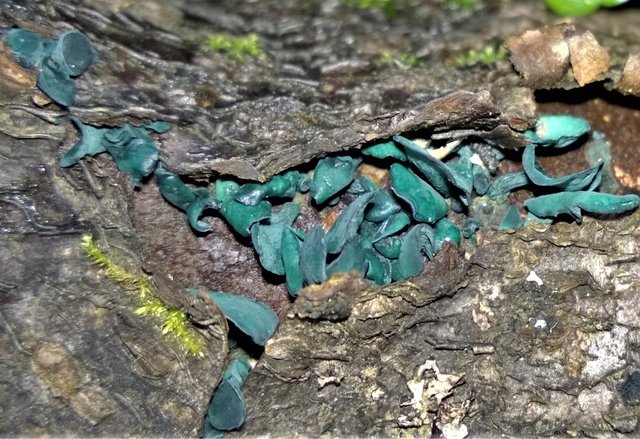Chlorocyboria blue-greenish (Chlorociboria aeruginascens)
- Department: Ascomycota (Ascomycetes)
- Subdivision: Pezizomycotina (Pezizomycotins)
- Class: Leotiomycetes (Leociomycetes)
- Subclass: Leotiomycetidae (Leocyomycetes)
- Order: Helotiales (Helotiae)
- Family: Helotiaceae (Gelociaceae)
- Genus: Chlorociboria (Chlorocyboria)
- Type: Chlorociboria aeruginascens (Chlorociboria blue-greenish)
:
- Chlorosplenium aeruginosa var. aeruginescent
- Peziza aeruginascens

Evidence of the presence of chlorociboria catches the eye much more often than itself – these are areas of wood painted in beautiful blue-green tones. Responsible for this is xylidein, a pigment from the quinone group.

The wood he painted, the so-called “green oak”, was highly valued by wood carvers since the Renaissance.
Mushrooms of the genus Chlorocyboria are not considered “true” wood-destroying fungi, which include basidiomycetes that cause white and brown rot. It is possible that these ascomycetes cause only minor damage to the cell walls of wood cells. It is also possible that they do not destroy them at all, but simply populate wood that has already been sufficiently destroyed by other fungi.

Chlorocyboria blue-greenish – saprophyte, grows on already quite rotten, bark-free dead trunks, stumps and boughs of hardwoods. The blue-green colored wood can be seen throughout the year, but fruiting bodies usually form in summer and autumn. This is a fairly common type of temperate zone, but fruiting bodies are rare – despite their bright color, they are very small.

Fruiting bodies are initially cup-shaped, with age they flatten, turning into “saucers” or discs of not quite regular shape, 2-5 mm in diameter, usually on a displaced or even lateral (less often on the central) leg 1-2 mm long. The upper spore-bearing (inner) surface is smooth, bright turquoise, darkening with age; lower sterile (outer) bare or slightly velvety, may be slightly lighter or darker. When dried, the edges of the fruiting body are wrapped inward.
The pulp is thin, turquoise. Smell and taste are inexpressive. Nutritional qualities due to the extremely small size are not even discussed.

Spores 6-8 x 1-2 µ, almost cylindrical to fusiform, smooth, with a drop of oil at both tips.
Outwardly very similar, but rarer, blue-green chlorociboria (Chlorociboria aeruginosa) is distinguished by smaller and usually very regular fruiting bodies on a central, sometimes almost completely absent, leg. It has a lighter (or brighter with age) upper (spore-bearing) surface, yellowish flesh and larger spores (8-15 x 2-4 µ). She paints wood in the same turquoise tones.









